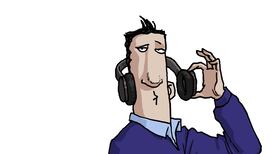If I had a Mastermind specialist subject, it would probably be 21st-century female television detectives, sub-category: Scandinavian variant. I can still remember the first time I saw Det Insp Sarah Lund on the television screen. She had hair like mine. Not the highlighted, blow-dried and shiny hair I used to have, but the halo of fuzz in a flat, lustre-free shade of brown that has re-emerged like an invasive weed in recent times.
The thing people remember most is the jumper. The white, itchy Faroese jumper with the black snowflake design. The jumper represented everything Det Lund was – practical, prickly and just here to do a job, with zero concessions to fashion.
I loved Sarah and that jumper so much that when an ex-boyfriend bought me a similar jumper as a Christmas present, I accidentally got back together with him. We could have had a beautiful spin-off show called Say Yes To The Jumper but it just wasn’t to be.
My Instagram-sharpened eye alighted on that split second of midriff reality like a drowning woman sighting a lifebuoy
Lund was the catalyst for a renaissance of female television detectives, and this has culminated most recently in Kate Winslet’s superb turn as Mare in Mare of Easttown on Sky Atlantic.
It had been a while since I had fallen for a female television detective. Kate in Line of Duty was okay, but she was no Saga Norén. But Mare is the real thing.
I identified more than I’d like with her thigh-chafing, vape-smoking, weary rumble through the world. Her home life is a bit neglected. Her ex-husband is about to remarry while she is living with her mother. She has a short fuse. She comes home from work and lays into the pizza and Rolling Rock before even taking off her coat. And, crucially, her body has suffered some very real-life consequences of this behaviour.
When the director of Mare of Easttown told Winslet he would edit out her untoned stomach in a sex scene, she refused to allow it. My Instagram-sharpened eye alighted on that split second of midriff reality like a drowning woman sighting a lifebuoy. Here, it seemed to say, is your ordinary body reflected back at you. Here is what happens when a 40-something woman gets undressed and engages with gravity. It even happens to Kate Winslet, I marvelled.
This was encouraging news. On a grander scale, it seemed to have an even more empowering message, which was, in a nutshell, you can have your pizza and beer, and still be desirable too. It’s a win-win situation.
I realise that it is a bit of a leap to describe Kate Winslet as an everywoman. She is, after all, a beautiful movie star, and they had to do terrible things with the lighting to make her skin look that bad in Mare of Easttown. But the home hair highlights were as authentic as any I’ve seen outside of my own house and, despite her fine bone structure, she was passable as an ordinary mother you might see down at the school gates.
Role models
We talk a big talk about self-love and body positivity but it rarely translates into what we see on screen. The result is that when we do see it, it feels inspiring.
Role models have always been important, particularly for young people. I’m a subscriber to the concept of “you have to see it to be it”. Watching Mare of Easttown, I realise that role models are important for everyone at any age, maybe even more so for middle-aged, overburdened women who have neglected to invest in a skin-care regime in the same way that some people neglect to start a pension. At this age, it all comes home to roost, which is why seeing any of these realities reflected on screen is both reassuring and empowering.
In the years since Sarah Lund kick-started the new breed of female detectives, they have become almost as familiar as the old, hard-bitten male detectives, but the reason I still love them is because they tend to represent women in a way we need to see ourselves – flawed and human.
They also offer an alternative example of how we can live our lives as we age. These characters have somehow managed to liberate themselves from the time-consuming female preoccupations of hair, make-up and clothes, with few negative consequences as far as I can see.
By opting out of these conventions, they’re showing radical self-acceptance and freeing up enormous headspace to do their work in the process. And it doesn’t have to be a Dworkin-esque reality – Mare still dresses up and sticks on lipstick for the odd date.
Female on-screen detectives are brilliant role models for ageing women. They show us that maybe we don’t have to go down the route of fillers, Botox and hair extensions. Maybe we don’t need to run faster and faster on that treadmill that tries to, but never can, outrun age. Maybe we don’t have to torture our tired bodies into somebody else’s idea of beautiful. Perhaps instead we can crack open a bottle of beer, eat a slice of pizza (or five) and accept ourselves as we are . . . and even invest in a nice, practical jumper while we’re at it.











